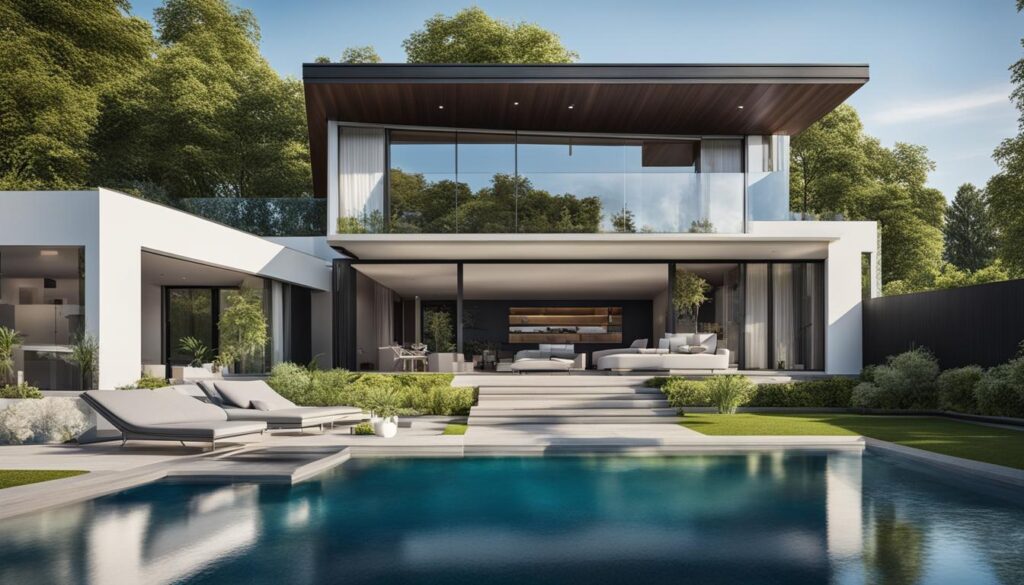We may earn money or products from the companies mentioned in this post.
Real estate photography is an essential aspect of property marketing, and it requires specific skills and techniques to produce high-quality images that showcase a property’s best features. Whether you’re a professional photographer or a property owner looking to improve your photography skills, the right tips and techniques can make a world of difference.
In this section, we will provide you with valuable real estate photography tips that can help you capture stunning photos of your property. We’ll cover everything from composition and lighting to editing and equipment, giving you the tools you need to take your real estate photography to the next level.
Key Takeaways
- Real estate photography requires specific skills and techniques to produce high-quality images that showcase a property’s best features.
- Composition, lighting, editing, and equipment are all essential elements of successful real estate photography.
- By mastering these tips and techniques, you can elevate your property’s portrayal and stand out in the competitive real estate market.
Understanding Real Estate Photography Techniques
Real estate photography requires a specific set of techniques to capture the essence of a property and highlight its best features. In this section, we will explore various approaches to composition, perspective, and framing that can elevate your real estate photography skills.
Composition Techniques
Composition is crucial in real estate photography. It involves arranging the elements in an image to create a balanced and visually appealing photo. The rule of thirds is a fundamental composition technique where the image is divided into thirds horizontally and vertically. The primary focal point of the image should align with one of the intersections.
Leading lines are another composition technique that can help draw the viewer’s eye to the focal point of the photo. Leading lines are lines in the image that lead the viewer’s eye to the focal point of the image. For example, a path or a road may lead to the house or a particular feature of the property.
Perspective and Framing Techniques
Perspective refers to the way the image is presented to create a sense of depth and dimension. Different perspectives can help highlight various features or characteristics of the property. For example, shooting from a low angle can make the rooms look more spacious, while shooting from a high angle can reveal the property’s surroundings.
Framing is the way the image is composed to direct the viewer’s attention to the focal point of the image. A well-framed image can help create depth and a sense of space in a photo. For example, framing a doorway or a window can create a natural frame around the focal point of the image.
Combining Techniques
Combining composition, perspective, and framing techniques can help create a compelling and visually appealing image. For example, using the rule of thirds, leading lines, and framing techniques can create an image with a natural flow and a clear focal point.
Mastering these real estate photography techniques can help you capture stunning images that showcase the true potential of your property.
Mastering Real Estate Photography Composition
Composition is a crucial element of real estate photography that can make or break your images. Proper composition techniques not only add balance and visual interest to your photos but also help you highlight a property’s best features.
The Rule of Thirds
The rule of thirds is a fundamental guideline in photography that can help you create visually appealing images. According to this rule, you should imagine your frame divided into three equal parts horizontally and vertically, resulting in nine parts in total. The points where the lines intersect are known as the “power points.”
By placing your subject at one of the power points, you can achieve a balanced and aesthetically pleasing composition. For example, you can position a fireplace at the bottom left power point to create an inviting atmosphere in your living room photo.
Leading Lines
Leading lines are natural or man-made lines that guide the viewer’s eye towards the subject of the photo. They can add depth and dimension to your images and create a sense of movement. Examples of leading lines in real estate photography include staircases, hallways, and roads.
To use leading lines effectively, position yourself in a way that the lines lead towards the main subject of your photo. For instance, you can capture a hallway from one end to the other, leading the viewer’s eye towards a beautiful view outside the window at the end of the hallway.
Frame within a Frame
Another composition technique that can add depth and interest to your photos is framing. Framing involves using elements within the photo as a frame for the subject. A common example of framing in real estate photography is using a window frame to showcase the view outside.
To achieve a frame within a frame effect, position yourself in a way that the element you’re using as a frame surrounds the subject. You can also use doorways, arches, or other architectural features as frames for your photos.
Table for Examples of Real Estate Photography Composition Techniques
| Composition Technique | Description | Example Image |
|---|---|---|
| The Rule of Thirds | Dividing the frame into thirds and positioning your subject at one of the power points. |  |
| Leading Lines | Using natural or man-made lines that guide the viewer’s eye towards the subject of the photo. |  |
| Frame within a Frame | Using elements within the photo as a frame for the subject. |  |
By mastering these composition techniques, you can create stunning real estate photos that highlight a property’s best features and attract potential buyers.
Harnessing Real Estate Photography Lighting
Lighting can make or break a real estate photo. To capture the best possible shots, it’s crucial to understand the different lighting setups and techniques. In this section, we’ll guide you through the basics of lighting for real estate photography.
Natural Lighting
Natural lighting is a popular choice for real estate photography as it can create a warm and inviting atmosphere. The best time to shoot with natural light is usually in the early morning or late afternoon when the sun’s angle is lower, creating softer shadows.
If you’re shooting indoors, try to use natural light by opening curtains and blinds to let in as much daylight as possible.
Ambient Lighting
Ambient lighting is another source of light that can help create a particular mood or atmosphere in your photos. It’s often used in interiors photography to add warmth and depth to a room.
When working with ambient light, it’s important to choose the right color temperature to achieve the desired effect. Cool light can create a fresh and contemporary feel, while warm light can provide a cozy and relaxing ambiance.
Artificial Lighting
If you’re shooting interiors, you’ll likely need to use artificial lighting to supplement the natural light. There are several types of artificial light sources that you can use, including:
| Type of Artificial Lighting | Best Use |
|---|---|
| Softbox | Great for creating even lighting in a room |
| Speedlight | Best for adding directional light to a specific area of a room |
| Ring light | Ideal for shooting close-up shots, such as details of a room or furniture |
When using artificial lighting, it’s important to balance it with the natural light to create a natural-looking photo. Avoid using too many different light sources as this can create harsh shadows and unnatural colors.
Exposure
Proper exposure is crucial to capturing high-quality real estate photos. Overexposed photos can look washed out and lack detail, while underexposed photos can appear dark and uninviting.
To achieve perfect exposure, it’s important to understand the three elements that affect exposure: aperture, shutter speed, and ISO. By adjusting these settings, you can control the amount of light entering the camera and achieve balanced exposure.
In summary, lighting plays a vital role in real estate photography. By understanding the different lighting techniques and using them to your advantage, you can capture stunning images that showcase the true potential of a property. Remember to use a balance of natural and artificial lighting and adjust the exposure settings to achieve the best results.
Essential Real Estate Photography Equipment
To achieve high-quality real estate photos, you need the right equipment. Here’s a list of essential equipment you’ll need:
| Camera | A DSLR or mirrorless camera is recommended for real estate photography. Look for a camera with a wide-angle lens, as it allows you to capture more of the room in one shot. |
|---|---|
| Tripod | A sturdy tripod is crucial for keeping your camera steady and reducing blur. A tripod also allows you to take multiple shots from the same angle, making it easier to create panoramic images. |
| Remote shutter release | A remote shutter release allows you to take photos without touching the camera, reducing the chances of camera shake and blurriness. |
| Memory cards | You’ll need memory cards with high storage capacity to store your photos. Look for cards with a high read and write speed for faster transfer to your computer. |
| Extra batteries | Keep extra batteries on hand to avoid running out of power during a shoot. |
| Flash | While natural lighting is preferred, a flash is essential for darker rooms or to balance out bright outdoor lighting. Look for an external flash with adjustable settings for more control. |
| Lens filters | Use lens filters to enhance colors, reduce glare or reflections, or to add special effects to your photos. |
| Cleaning kit | Keep your camera and lenses clean with a cleaning kit that includes a microfiber cloth, lens cleaning solution, and a blower brush. |
Consider investing in high-quality equipment to produce professional-level real estate photos.
Polishing Your Real Estate Photos with Editing
Editing is an essential part of real estate photography. Even if you have captured the perfect shot, editing can help enhance colors, remove distractions, and bring out the best in your images. In this section, we will guide you through the editing process and share some real estate photography editing tips and techniques for achieving professional results.
The Importance of Editing in Real Estate Photography
Editing is the process of adjusting and improving your photos to create the desired effects. It can help you make your images stand out, and present your properties in the best possible light. With editing, you can:
- Enhance colors and contrast
- Adjust exposure and brightness
- Remove distractions and blemishes
- Straighten and crop the image
- Add or remove objects in the photo
By editing your photos, you can create professional-looking images that are more attractive to potential buyers.
Real Estate Photography Editing Tips and Techniques
Here are some real estate photography editing tips and techniques to help you improve your images:
- Adjust white balance: Correct the color temperature in your images by adjusting the white balance. This can help eliminate color casts and make your images look more natural.
- Apply lens correction: Correct lens distortion and vignetting using lens correction tools. This can help straighten the lines and edges in the photo.
- Use the clone stamp: Remove unwanted distractions and blemishes using the clone stamp tool. This tool copies pixels from one area and pastes them onto another.
- Adjust exposure and contrast: Boost the brightness and contrast in your images to add depth and visual interest.
- Apply sharpening: Sharpen your images to add clarity and detail.
- Add saturation: Increase the saturation to make the colors pop and add vibrancy to your images.
Popular Real Estate Photography Editing Software
There are several photo editing software options available, and choosing the right one can be overwhelming. Here are some popular software options used by many real estate photographers:
| Software | Pros | Cons |
|---|---|---|
| Adobe Lightroom |
|
|
| Photoshop |
|
|
| Canva |
|
|
Choosing the right software depends on your editing needs, budget, and skill level. Consider testing out different software options to find the best fit for you.
Real Estate Photography Editing Best Practices
Here are some best practices to keep in mind when editing your real estate photos:
- Don’t over-edit your photos. Keep the changes subtle and natural-looking.
- Avoid using filters and presets, as they can make your photos look artificial.
- Ensure that the final image represents the property accurately; don’t create a false representation of the property.
- Save a copy of the original image before making any edits.
By following these real estate photography editing tips and techniques, you can enhance your images and create a professional-looking portfolio that will attract potential buyers.
Real Estate Photography Tutorial for Beginners
Real estate photography can be a rewarding career or a useful skill for selling your own property. In this tutorial, we’ll cover some basic real estate photography principles that will help you capture high-quality images to make your property stand out.
Real Estate Photography Tips and Tricks
- First impressions are important. Make sure the property is clean and decluttered before taking pictures.
- Take photos during the day when natural light is abundant.
- Shoot from several angles to capture a variety of perspectives.
- Use a tripod to keep the camera steady and avoid blurry images.
- Take advantage of the rule of thirds for balanced and visually interesting compositions.
Real Estate Photography Best Practices
Before you start shooting, familiarize yourself with your camera’s settings and features. Here are some tips:
- Use a wide-angle lens to capture more of the room in one photo.
- Shoot in RAW format to retain more image data for editing purposes.
- Set a low ISO to reduce noise and grain in your photos.
- Use a high aperture number (f/8 or higher) for a wider depth of field.
- Use the camera’s timer function or a remote shutter release to avoid camera shake.
Real Estate Photography Camera Settings
Here are some recommended camera settings for real estate photography:
| Camera Setting | Recommended Value |
|---|---|
| Aperture | f/8 or higher |
| ISO | 100-400 |
| Shutter Speed | 1/60 sec or faster |
Conclusion
Real estate photography is a critical aspect of property marketing that cannot be overlooked. By following the tips and techniques discussed in this article, you can master the art of real estate photography and capture stunning images that showcase the true potential of your property.
Understanding real estate photography techniques such as composition, lighting, and framing, and equipping yourself with the right equipment can make all the difference when it comes to standing out in the competitive market.
Remember that editing is a crucial step in real estate photography that shouldn’t be skipped. It’s essential to polish your photos with the right editing software to achieve professional results that attract potential buyers.
If you’re new to real estate photography, don’t worry; this article provides a step-by-step tutorial that covers the basics from setting up your camera to capturing the right compositions and angles. By applying these tips and tricks and practicing real estate photography best practices, you’ll be able to excel and elevate your property’s portrayal.
Mastering real estate photography is a journey that requires patience and practice, but with these tips and techniques, you’re well on your way to becoming a successful real estate photographer.
FAQ
What are some tips for enhancing my real estate photography skills?
To enhance your real estate photography skills, focus on capturing the true potential of the property by highlighting its best features. Pay attention to composition, lighting, and editing techniques to create captivating images that draw potential buyers in.
What real estate photography techniques should I understand?
It is important to understand various techniques in real estate photography. These techniques include composition, perspective, and framing. By mastering these techniques, you can capture the essence of a property and showcase it in the best possible way.
How can I improve the composition of my real estate photos?
Composition plays a crucial role in real estate photography. Focus on using the rule of thirds, leading lines, and other composition techniques to add balance and visual interest to your images. By mastering composition, you can create captivating photos that grab attention.
What should I know about real estate photography lighting?
Lighting is a key element in real estate photography. It is important to understand and utilize different lighting setups and techniques, including natural, ambient, and artificial lighting. Proper exposure and using lighting to create a warm and inviting atmosphere are also crucial.
What essential equipment do I need for real estate photography?
When it comes to real estate photography, having the right equipment is essential. Some must-have equipment includes cameras, lenses, tripods, and other accessories. Consider your budget and skill level when choosing the right equipment for your needs.
How can I improve my real estate photos through editing?
Editing is a crucial step in real estate photography. Learn techniques for enhancing colors, adjusting exposure, and removing distractions. Familiarize yourself with popular editing software and apply editing techniques to achieve a professional finish.
Do you have a tutorial for beginners in real estate photography?
Yes, we have a step-by-step tutorial for beginners in real estate photography. This tutorial covers the basics, from setting up your camera to capturing the right angles and compositions. We also provide tips and tricks, best practices, and recommended camera settings for optimal results.
Affiliate Disclosure: This post may contain affiliate links. If you purchase through our link, we may receive a small commission, but at no additional cost to you. For more information, please see our Disclosure statement.



